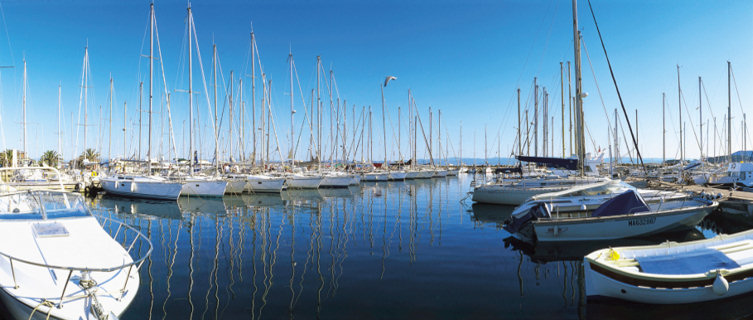
Hyeres port
© Thinkstock / Goodstock
Hyères beaches
Famed for its palm trees (7,000 of them apparently), Hyères, the most southerly city of Provence, was once the favourite summer resort of the rich and famous. Today's celebrities and well-heeled visitors might have moved on to resorts further east along the coast, but the old town retains its charm and character. Only a few kilometres to the northeast of Hyères, the Massif des Maures is great for hiking, while the Giens Peninsula (and the isthmus that leads to it) to the south draws the crowds with its long, sandy beaches. The Iles d'Or (also known as Iles d'Hyères) are famed for their transparent turquoise waters and white sands, and are a must-do in summer. Porquerolles is the biggest, while Port Cros is a national park with typical Mediterranean flora and fauna. Hyères harbour, Port St Pierre, which is home to many yachts and other bateaux de plaisance, is a first-rate boating centre. It has been adopted by the French sailing team as their home port.
The Hyères commune boasts 39km (24 miles) of pristine sand beaches and rocky inlets. The isthmus leading to the Giens Peninsula is home to salt marshes and umbrella pines. The beaches here are very popular and can get crowded in summer. The 5km-long (3 miles) beach L'Almanarre is the closest to Hyères, and as such it is the busiest. Beaches on the Giens Peninsula are less crowded. The islands have plenty of little coves, many of which can only be reached by boat. Of the big beaches on Porquerolles, La Courtade is the longest and most popular. The Plage des Grottes on Ile du Levant is reserved for naturism. Watersports on offer include scuba-diving (some of the most exciting shipwreck sites in the Mediterranean can be found nearby), sailing, deep sea fishing and yachting.
Explore the old town. Start at place Massillon, the main square, which is home to the daily market. The 12th-century Tower of St Blaise on place Massillon is a local landmark. There is a maze of little streets to the north of the square, lined with old houses of typical soft pastel Provençal colours. Built in the 1920s, the Villa Noailles (montée de Noailles) was once a beacon of modernity, attracting avant-garde artists and their friends. Today it is a cultural centre that hosts a fashion and photography festival every year, and draws those interested in contemporary architecture. Parc St Bernard, just below the villa, is a good place for a stroll, and offers great views of the coast and old town.
Hyères beaches are ideal for families, with clean, safe waters and lifeguards on duty. The Magic World fun park, on the D42 road (route Marais) just west of Hyères-Plage, is open from June to September, and is a popular attraction with children. So is the Jardin Olbius-Riquier (avenue Ambroise Thomas), which features numerous rare and exotic plant species, a lake, an exotic greenhouse, a cactus garden, a playground, a miniature train and even pony rides. It offers some welcome shade in the hot afternoon sunshine and is a good spot for a family stroll. Horse-riding is widely available, as is bike hire, and there is go-karting on the avenue de l'Aéroport.
Porquerolles, the most westerly of the Iles d'Or (also known as Iles d'Hyères), is the closest to Hyères. The northern part of the island is the most built up, while the southern coast still boasts beautiful, unspoilt little coves of turquoise waters and white sands. An excursion to the nearby island of Port Cros, a national park with typical Mediterranean fauna and flora, is another option.
Treat yourself and go on an underwater photo safari. Alternatively just hire a boat for the day (or week) and go explore the area on your own. More than 80 local companies offer motor- and sailboat rentals, with or without skipper and stewardess service. Or learn to sail: several sailing schools offer courses covering basic nautical skills, and you can even get a sailing permit at the end of it.
Do you have any Feedback about this page?
© 2025 Columbus Travel Media Ltd. All rights reserved. No part of this site may be reproduced without our written permission, click here for information on Columbus Content Solutions.






 You know where
You know where